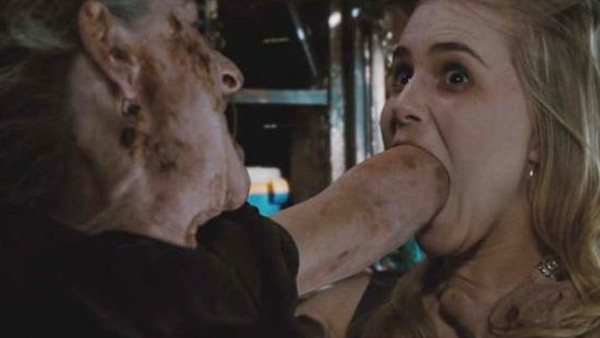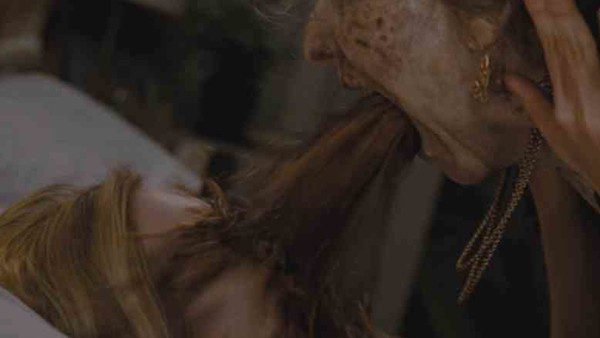Drag Me To Hell Film Theory: A Metaphor For An Eating Disorder
There's more than demonic curses that Christine can't stomach.

From the mind of the man behind Evil Dead, Drag Me To Hell is another body horror spectacle that has disgusted and entertained audiences in equal measure, telling the tale of a woman desperately seeking reprieve from a demon after her soul. But what if there’s more to the bodythan just horror in this film?
From the mind of the man behind Evil Dead, Drag Me To Hell is another body horror spectacle that has disgusted and entertained audiences in equal measure, telling the tale of a woman desperately seeking reprieve from a demon after her soul. But what if there’s more to the body than just horror in this film?
There’s one theory that has struck a chord with viewers continuously since its release: that Christine isn’t actually running from supernatural forces, but a psychotic break brought on by bulimia. It's a coin toss on which one is more disturbing.
Drag Me To Hell is the story of a young career-minded woman, Christine Brown, who refuses a loan to a struggling pensioner, Mrs Ganush, in the hopes of getting a promotion. As that would be a terribly boring story on its own, Mrs Ganush then curses Christine - condemning her to a series of grisly and disgusting ordeals. Christine has three days to break the curse or the demon Lamia will take her soul to hell for all eternity: cue lots of vomiting into Christine's mouth, eyeball-flavoured cake, and a nosebleed that could rival Niagara Falls in its stomach churning intensity.
All these things could seem innocuous when linked back to the curse, truthfully - but what if there’s something more swimming around in these bodily fluids than meets the eye? There's plenty of symbolism peppered throughout the movie that indicates a parallel storyline: one that notes a terrifying everyday truth rather than cinematic embellishment.
Firstly, Christine is depicted continuously as a woman who wants to change. From the very opening of the film, we’re bombarded with a quiet unhappiness from our protagonist, as we see her trying to eradicate her Southern accent with a self-help elocution tape on the way to work, then stare longingly into a cake shop window - clearly steeling herself against giving in to the treats inside.
This is important, and it’s the first clue to Christine’s relationship with food that permeates throughout the rest of the movie, and foreshadows the reveal of her past. That past, it would have it, is one of ‘a little fat girl’, as one character delicately puts it; Christine being the Pork Queen of her local fair in 1995, which we get a glimpse of in a photograph that slips out of a cooking book that she then quickly destroys. See how food and shame are starting to interlink?

Christine has obviously come a long way from the past she's ashamed of, but still isn’t good enough in the eyes of everyone around her. She’s competing for a promotion at work, put down by her boss and coworker, and her boyfriend’s mom wishes he was with someone else, trying to set him up with other dates within earshot of poor Christine. Her unhappiness is then channeled into becoming the perfect woman, one that can tick all the boxes that she currently feels like she's failing, and this impossible task is attempted through bulimia. The one thing she can get true control of in her life is her diet, which is then taken to horrifying extremes in pursuit of happiness and success.
“How does this relate to Mrs Ganush and the Lamia?” I hear you cry, and that’s where the theory gets interesting. The visit from Mrs Ganush can be seen as a representation of Christine’s future self if she doesn’t stop the harm she’s putting her body through. With broken, yellowed nails, damaged skin, and stringy hair, Ganush is the accumulation of symptoms associated with bulimia, and a vision of what Christine will become - hence her attempts to deny the old woman and push her out of her presence and mind: she ignores her symptoms as 'just a little longer' can earn her a promotion.
Her curse on Christine from the Lamia (who in fact shares the name with a woman cursed to unhappiness and feasting on flesh in Greek mythology) is a physical expression of her inner demons: it knows about her disorder that she desperately tries to hide. It attacks her in the kitchen and turns her cooking utensils against her, it appears silhouetted with what could be seen as pig hooves, and throws up her own cat in rejection of the ‘food’ it is offered.

Of course, vomit is another giant portion of this theory, as Raimi offers scenes of oral fixation over and over again. Christine is constantly battling things trying to force their way down her throat, which includes Ganush’s own regurgitated embalming fluid and used handkerchief, in symbolic realization of her relationship with eating. As the film progresses, so does the inclusion of blood in these sequences, showing the damage internally inflicted on Christine getting more and more serious.
When she does actually try and consume cake at her boyfriend’s house, an eye appears in the dessert, watching her every move in judgemental fashion. By forcing herself to have it regardless of her disgust, she then struggles to swallow, instead choking on the dessert in an uncomfortable display of her own rejection of eating.
Eventually, she coughs out a fly - perhaps representing the decay of her body, or even the disgust in herself for actually consuming the product when she’d resisted so much previously. There’s no winning when she eats or when she doesn’t eat, the frustration of her inner battle between keeping herself alive, and becoming the image of perfection, in constant flux.
There is plenty more that supports the theory of Christine’s bulimia, but we’ll end where it’s most appropriate - surprisingly, at the end. Christine’s only way of saving her soul from the Lamia boils down to her decision to shove the cursed button down Mrs Ganush’s throat, and it fails. The eating disorder is her problem, her curse, and she tries to solve it by repeating the very same behaviours she needs to stop, and is forever doomed because of it.
The final image of Christine is her withering away to a skeleton, fighting against inevitable death. In this sped up and dramatised version of events, it's the only result her actions could have ever accomplished.
What do you think of this theory? Share your reactions below in the comments thread.